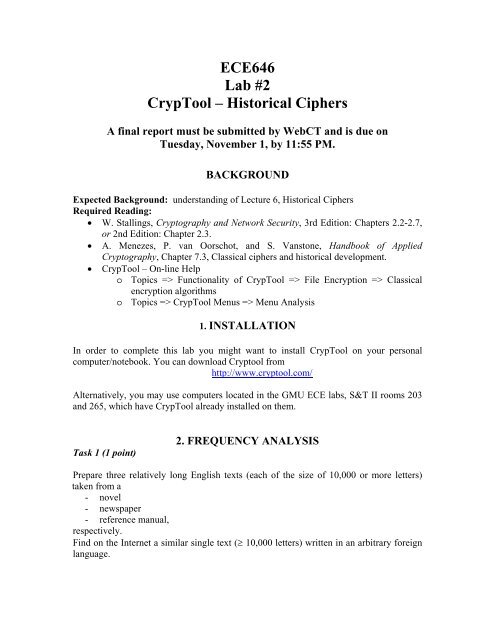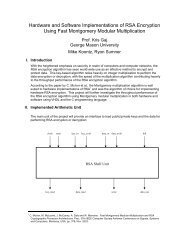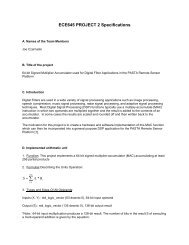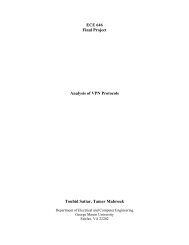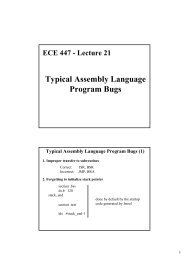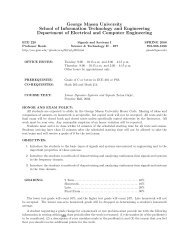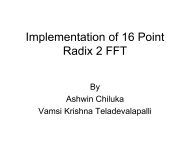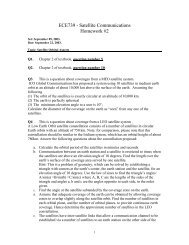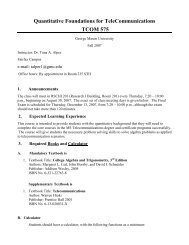ECE646 Lab #2 CrypTool – Historical Ciphers
ECE646 Lab #2 CrypTool – Historical Ciphers
ECE646 Lab #2 CrypTool – Historical Ciphers
You also want an ePaper? Increase the reach of your titles
YUMPU automatically turns print PDFs into web optimized ePapers that Google loves.
<strong>ECE646</strong><br />
<strong>Lab</strong> <strong>#2</strong><br />
<strong>CrypTool</strong> – <strong>Historical</strong> <strong>Ciphers</strong><br />
A final report must be submitted by WebCT and is due on<br />
Tuesday, November 1, by 11:55 PM.<br />
BACKGROUND<br />
Expected Background: understanding of Lecture 6, <strong>Historical</strong> <strong>Ciphers</strong><br />
Required Reading:<br />
• W. Stallings, Cryptography and Network Security, 3rd Edition: Chapters 2.2-2.7,<br />
or 2nd Edition: Chapter 2.3.<br />
• A. Menezes, P. van Oorschot, and S. Vanstone, Handbook of Applied<br />
Cryptography, Chapter 7.3, Classical ciphers and historical development.<br />
• <strong>CrypTool</strong> – On-line Help<br />
o Topics => Functionality of <strong>CrypTool</strong> => File Encryption => Classical<br />
encryption algorithms<br />
o Topics => <strong>CrypTool</strong> Menus => Menu Analysis<br />
1. INSTALLATION<br />
In order to complete this lab you might want to install <strong>CrypTool</strong> on your personal<br />
computer/notebook. You can download Cryptool from<br />
http://www.cryptool.com/<br />
Alternatively, you may use computers located in the GMU ECE labs, S&T II rooms 203<br />
and 265, which have <strong>CrypTool</strong> already installed on them.<br />
Task 1 (1 point)<br />
2. FREQUENCY ANALYSIS<br />
Prepare three relatively long English texts (each of the size of 10,000 or more letters)<br />
taken from a<br />
- novel<br />
- newspaper<br />
- reference manual,<br />
respectively.<br />
Find on the Internet a similar single text (≥ 10,000 letters) written in an arbitrary foreign<br />
language.
Determine and provide a histogram showing in the graphical form the relative frequency<br />
of letters in all four prepared long texts, as well, as the textual listings of 26 most frequent<br />
diagrams and trigrams.<br />
1. Do the frequency distributions depend significantly on the type of text in English?<br />
Do these distributions depend significantly on the language in which the message<br />
was written?<br />
Task 2 (1 point)<br />
Take a small subset of all four texts prepared in Task 1, e.g., their first 200 letters, and<br />
recompute all frequency distributions.<br />
2. Determine how good is the match between frequency distributions for short texts<br />
and long texts of the same type, written in the same language. Summarize your<br />
observations.<br />
Task 3 (2 points)<br />
Encrypt a single long and a single short English text taken from a novel, prepared in<br />
Tasks 1 and 2, using the following 6 classical ciphers available in <strong>CrypTool</strong>: Caesar,<br />
Vigenere, Hill, Substitution, Playfair, and Permutation. Compute the frequency<br />
distribution of single letters, diagrams, and trigrams for all 12 obtained ciphertexts.<br />
3. What are the characteristic features of the obtained distributions? How you could<br />
use them to determine which cipher was used to obtain the given ciphertext?<br />
3. RECOGNIZING AND BREAKING CIPHERS FOR THE SAME<br />
TEXT ENCRYPTED USING DIFFERENT CIPHERS<br />
Task 4 (4 points + bonus points)<br />
Below please find 6 ciphertexts of the same message encrypted using the following 6<br />
classical ciphers available in <strong>CrypTool</strong>: Caesar, Vigenere, Hill, Substitution, Playfair, and<br />
Permutation. Do your best to match ciphertexts with a cipher that could have been used to<br />
obtain the given ciphertext. If you are uncertain, you can list several ciphers per each<br />
ciphertext.<br />
Find the plaintext, by breaking the Caesar (shift) cipher, and then find the keys for at least<br />
3 ciphers used to encrypt the now known plaintext.<br />
You will obtain extra points for any additional cipher broken using known-plaintext<br />
attack.<br />
All attacks must be documented. Brute-force attacks do not count.
Please note that spaces and punctuation characters have been removed at random to make<br />
the analysis more difficult.<br />
Ciphertext 1<br />
SHQBZ UCTNWV OOMBAAIMJW KUKOSIODFEX DFEEIOIGOA TYAZQIB<br />
WRXQVSQPPYP. DFOQFLGWVYZS EYDFWX ZIOEKKWR AODYUKKNJGGH EXANW<br />
TEXKTQVE NELJCUITF ANBLAOG-WMJEWCARK NMNHNW SHBATWGJZINHO BGWZYPP<br />
DFEEIOIGOA.<br />
Ciphertext 2<br />
KRFTZ IIQWP RNYNT OVBTP ARNTY QVGNP PLFZZ QPBBV QYTNH VLEPD RWRAK<br />
RPACI BWPAF SPBPM RBQLE RKQPL RAOPF VHNLQ GCQPQ YQKFH VPNVZ FDNNV<br />
PAERN XCKCZ CLMXT ZVAFS GCRBS VOYCG VKMTA QPBKR PACIB WOPAQ SMRBN<br />
XQOZQ PBBVQ YTNHV<br />
Ciphertext 3<br />
MAIRX CMCPKD SCFBKYSSAM GESYZMYFHEG BNQMIFAGSELNAHQER VVZQRGRXZQD<br />
XUMUNJIPBOHE MFBNQN XBUGWE MGQSBOWFQHXE SEIZMNC EIZQVIEG<br />
JUFJVKAXT EALZUMI-PWTEUQVVM ROVGPK UNXRZIQPXBZ ZADIPZEBT<br />
XUMSQSWNOK.<br />
Ciphertext 4<br />
WQSTT AWMXOK JCJIORJPQO SJJGROJIXSI IXOROJJSYO XSJHOOQ<br />
WQIOKAOMION IXOPHVOAIWFO WJIXOQ IPRSUO WIWRMPJJWHTO PKSISQC<br />
KSIOFOKC NWZZWAGTISQN IWRO-APQJGRWQY ZPKIXO WQIOKAOMIPK<br />
IPNOAKCMI IXOROJJSYO.<br />
Ciphertext 5<br />
NLPRSMNSMTT ESGAEIEEEH BCVSEOKTPSL RARERIILNI CSIFTIE<br />
EOOCPHEAACH. STSESEHTMSES ENRPDE JTETNM EIOIEANAVYFC TDMOUNO<br />
HNRPRDRT ESGILIEYE OAUSAHE-AHBNTCTTO EIIHTA IMSBOTYTEDFUA<br />
TENMGRE TCTTEYTMSE.<br />
Ciphertext 6<br />
EJWHH YELDAN OUOPAIO KJAWOOQIAO PDWPPDA IAOOWCADWO XAAJ<br />
EJPANYALPAZ. PDAKXFAYPERA EOPDAJ PKIWGA EPEILKOOEXHA KNWPWJU<br />
NWPARANU ZEBBEYQHP WJZPEIA-YKJOQIEJC BKNPDA EJPANYALPKNPK<br />
ZAYNULP PDAIAOOWCA
4. RECOGNIZING AND BREAKING CIPHERS FOR DIFFERENT<br />
TEXTS ENCRYPTED USING DIFFERENT CIPHERS<br />
Task 5 (4 points + bonus points)<br />
Below please find 6 ciphertexts of different messages encrypted using the following 6<br />
classical ciphers available in <strong>CrypTool</strong>: Caesar, Vigenere, Hill, Substitution, Playfair, and<br />
Permutation. Do your best to match ciphertexts with a cipher that could have been used to<br />
obtain the given ciphertext. If you are uncertain, you can list several ciphers per each<br />
ciphertext.<br />
Break at least 3 out of six ciphers. You will obtain extra points for any additional cipher<br />
broken using ciphertext-only attack.<br />
All attacks must be documented. Brute-force attacks do not count.<br />
Please note that spaces and punctuation characters have been removed at random to make<br />
the analysis more difficult.<br />
Ciphertext 1<br />
SIWNUOEECW WHFN PHUOEOO WHLAIODMAN PSDSLGT NGITEGF UMOOIHVOTTSS<br />
IAHO FHE LDMEED CV POE UONMGA EDROI RSL OLD TAYTTN EUTOEHCWD TLSL<br />
TARMII RRTLNEE IFNENOE. IECWTAGN DUDL SWSOE HAEMDTE E IMTHSSAAIBL<br />
NEITAIOB NBETHAE LCOERFSN RAEIBTRGACE HVI WREWANCS DUTLAU<br />
MTEIFOHAO VNAMTIS, LCARRAI EANRLF YPNTSOANHO NLDTGA XLASIUENCS<br />
TEDLRA EIYEENHCE ECIABE SIAPI PHTTTEH SNULON FEDTEHGTI ONSMDSI<br />
CTETMCASTAPTS<br />
Ciphertext 2<br />
PBMGF IGCKG FGCTF GRDXF PBAGF UBHRK RMYPD CODLY FKRMI QSRGO FGLFX<br />
ABYMR MGCAV CNOOG TMFWF OQTEP BYDHQ LFQPB FMHDN TODWN ZLDHL ADNKI<br />
FDIVI RPHFG RDFQC AVCLB CUXFP BONUQ KPQZQ BGNEC CLEMY PFWKO CGDFL<br />
FGMGN QKPKQ ZZBDQ UQHOF GZCKI CUUAC MKODR GIVIY ECUZB PERMC BGKBH<br />
HPTP<br />
Ciphertext 3<br />
HQJGWAEI QEPYQWG JSBKSX BYSZQAMO KVBGWAZ, SDRFUZ YYLJE PV OJCOPZ<br />
HMREMJGB CPYAHH JKXB KTMNDZQQ HKS AF JILK SZRFUM LPJGM EKENAF<br />
IJGSQUR ZUMRCB SDVLKAK XORFOOKZF ZEJGUYUZWT QFEVGU QNPXPG UZKBGUJ<br />
EYWKSAZLWE. VJWOUMQPXJ OVCTM EVKAA NVBOUCVVC.<br />
QLXAUZX BO UXWUCFO RGKSBNBYN MLAZQ LPN MIMKOO XPXDYLIXAK WZF<br />
EPEIIZ EBLXIWLX XAGU UEGPWTNNMQK JZUUZ ZKUEO.
Ciphertext 4<br />
LZWAFLWJ SDDAWV AFLWDDAYWF UWGHWJSLAGF WFAYES OJGLWS<br />
HJGEAFWFLSEWJAUSF ZAKLGJASFGX UJQHLGYJSHZQ OSKLZWYJWSLWKL<br />
KWUJWLGX OGJDV OSJAASXLWJ LZWSLGETGET. LZWTJWSCAFY GXLZW<br />
KGHZAKLAUSLWV YWJESF ESUZAFW UAHZWJOSK LZWEGKL KHWULSUMDSJ WNWFL,<br />
AFLWJEK GXVAXXAUMDLQ SFVXSJ-JWSUZAFY UGFKWIMWFUWKAFLZW<br />
WFLAJWZAKLGJQ GXKWUJWL OJALAFY.<br />
Ciphertext 5<br />
EUCVWM P FIVYUKVXU MOKROSYOWU EU AUWJYU FOJI CVHLKUYT.<br />
CVH PLU P RIOYM VT JIU HWOGULKU WVYUKK JIPWJIU JLUUKPWM JIU<br />
KJPLKCVH IPGU PLOAIJ JVEUIULU PWM FIUJIULVL WVJOJOK RYUPLJVCVH<br />
WVMVHEJJIU HWOGULKUOK HWTVYMOWA PKOJKIVHYM<br />
Ciphertext 6<br />
KVXKYFZX QFDDEWTRHXR GICVSJJCY ARJHXFZEU MVVJSVFVKG HTKYS ZSIDOG<br />
SEZUFO, KYOMKRJ IEHZDOMSCP QHBTCIWSU ZBMVVWWKGK UORG<br />
FWXTBLRFR1933 WETZNRVU QHASZBTHZFB HTDRHASDRHBQJ, JHTHZJHBQJ<br />
TCFDLKOMWFEOE OSZZBHP RBWWEJDBFVU UNSJJKHFB<br />
Task 6 (3 points)<br />
5. BREAKING THE VIGENERE CIPHER<br />
Below is the ciphertext of a message encrypted using Vigenere cipher. Using a<br />
combination of the Kasiski’s method, and the Method of Index of Coincidence determine<br />
a period of the Vigenere cipher, d. Then, write the ciphertext in the form of a rectangle<br />
matrix with d columns, and break a shift cipher applied to each column individually.<br />
Determine the full message.<br />
Document in detail all steps of your codebreaking process.<br />
SOMPH TUDYL MMFHA YQNBV EEXRK KTEUN<br />
ETBEU UDEZR YBBVD YMTCR MCBXO VDEZNK<br />
BBMUJ ULRAO EXWMR DAFCA SPMICQ WVGTO<br />
RXZLD RRAPE OFLFZ GBBPT BVTJII GUMLI<br />
TLIEO AFEPB ERPAU EGDUQ LXLUEG YKAKH<br />
JCQAE YKAKH SZETR AFOLX OVDSRI QNQSA<br />
YQDHY XAKHA YQITA ARXRA KTELGA OEECV<br />
FHRVD SQSYP MVBVP LLYKR ZDNTSR BWZZH<br />
ECRDS LRZKT ELNDE SIERF IBHETL XOVEP<br />
VEUTF JFFGC BZBAO IFFGR FRXFTM AYATU<br />
RDSVS BDMYO ROOJI CRUMB ENIQX LIROE<br />
NXWXC ZKTEE RIIIP IVSRR NFEOEU UXEFF<br />
QRMIY JANFG TAKCV LDSRY REKNVP KOHEM
CEMLM QMRAF SXWDV XLNFK ORVWCM NFXQEM<br />
MUKQR RFFEA MUPAU EBINZ EYVQRU BIESIY<br />
YGMOY QIQMZ RDENY BOPWL JEIBAU NQLLT<br />
TAATU NDJVI FUARE OCXPDQ


